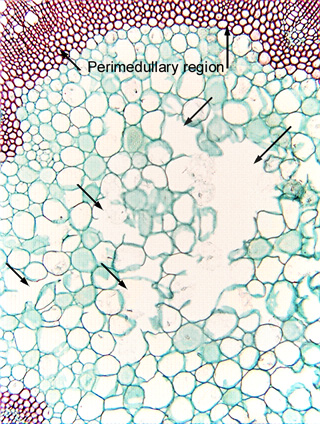 Fig.
11.4-3. Transverse section of ivy stem (Hedera helix). In some
plants, the pith seems to play a minor role in storing water or starch or
crystals, but in general, the pith of most stems is so small that it has too
little volume to be a significant storage space. In a number of species, the
pith seems to have no function whatsoever – its growth does not keep up with
that of the surrounding vascular tissues, cortex and epidermis, so
the pith is torn apart as internodes expand. This has occurred in
this region of ivy stem, with the arrows indicating the many areas where pith
cells have simply been torn apart. This is easy to see for yourself – just cut
a young stem longitudinally and often you will find a hollow chamber rather than
an intact pith.
Fig.
11.4-3. Transverse section of ivy stem (Hedera helix). In some
plants, the pith seems to play a minor role in storing water or starch or
crystals, but in general, the pith of most stems is so small that it has too
little volume to be a significant storage space. In a number of species, the
pith seems to have no function whatsoever – its growth does not keep up with
that of the surrounding vascular tissues, cortex and epidermis, so
the pith is torn apart as internodes expand. This has occurred in
this region of ivy stem, with the arrows indicating the many areas where pith
cells have simply been torn apart. This is easy to see for yourself – just cut
a young stem longitudinally and often you will find a hollow chamber rather than
an intact pith.